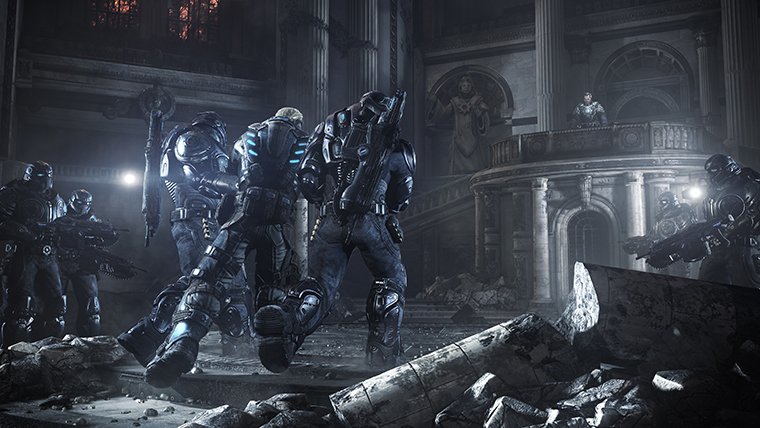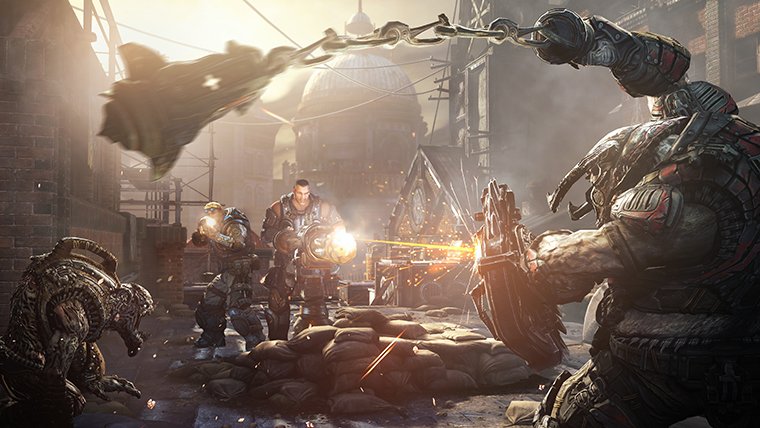It wasn’t that long ago that we were wrapping up the Gears of War trilogy in fitting fashion. Gears of War 3 put the conflict between the Locust and COG in the rear-view, and because of that, many fans were blindsided with the prequel announcement of Gears of War: Judgment. Add in the fact that Epic Games saw key members of the Gears of War team leave the company for other pursuits, and Gears of War: Judgement raised red flags. It turns out that it wasn’t really warranted, the franchise is in great hands with People Can Fly, and they’ve made some changes to the game that seem more natural than jarring.
Gears of War: Judgment takes players back in the Gears of War timeline. It goes all the way back to before the original Gears of War, shortly after the Pendulum Wars. As the Locust are emerging on Sera’s surface, this story is centered around the Kilo Squad. This team consists of familiar characters Baird and Cole, with newcomers Sofia Hendrick and Garron Paduk to fill out the roster. Judgment is the story of this team taking matters into their own hands, disobeying orders, and are now facing court martial for their actions. Their story is told in retrospect, with each member of the team recanting a portion of the mission.

Declassified missions force players to step outside their comfort zones
While the way the story is delivered in Gears of War: Judgment is somewhat different, it’s no less serviceable than previous Gears of War games. It’s not the crown jewel of storytelling, but that’s the tradeoff for some of the best third-person cover-shooter action around, enveloped in the best visual package you’ll find on the Xbox. Gears of War: Judgment’s finer details are explained while behind the barrel of a weapon, as opposed to a cinematic cutscene. With each chapter, players will take control of a new member of the Kilo squad as they testify to the events of a mission gone awry. They can take the vanilla route, which would be akin to traditional Gears of War mechanics, or they can take the “Declassified” route, a new gameplay device from People Can Fly that adds modifiers to the combat as well as color to each mission. This Declassified system is what makes Judgment standout from other Gears of War games. It makes the combat harder, more rewarding, and aesthetically different at different points in the campaign. It also forces players to step outside their comfort zones, use weapons they wouldn’t normally use and deal with different, more difficult situations.
The third person cover combat that spawned a generation of similar shooters is still very much the draw here. Though this time around, the shooter now feels like a much faster breed. The pacing of combat is less deliberate and far more chaotic, likely due to a combination of subtle control scheme shifts and the variations of enemy types that are thrown at the player throughout the campaign. Players familiar with the Gears of War series will immediately notice that changing weapons is a much faster process, having been moved from the d-pad to the y-button. Grenades have been mapped to the left bumper, and they also seem much faster than previous games considering that you don’t have to select them. Though aside from the control and pacing shifts, it’s all very much familiar territory for Gears fans. The game is still best in class at what it does, whether playing the campaign as a solo C.O.G. with A.I. squad mates, or going online for cooperative play.
The six act Judgment campaign will probably take around eight hours to complete on solo at normal difficulty, but the addition of the Declassified System, C.O.G. Tags, higher difficulty levels, and the cooperative play, make it a mode with significant replay value. The levels are a mixture of straight forward shootouts and hold-out events that are similar to the horde mode from previous games. The Declassified segments will add some color to the default flavor of the Judgment campaign, which does fall back on enemies that we’ve seen in previous games. When that fun finally does run out in the Judgment campaign, the single player side of things also offers another campaign that acts as a side story for Gears of War 3. It reunites the squad mates from the Judgment campaign to the Gears 3 “Aftermath” campaign for some crossover and additional back-story for the characters.
The intended way to play Judgment’s story mode is likely the least comfortable method to you. That’s a weird philosophy, and People Can Fly hasn’t come out and said that, but they might as well should have. They obviously wanted to shake things up with Judgment. After three games in the series, people tend to establish their favorite weapons and methods of dispatching the locust horde. With Judgment, if you want all you can get out of this game, you’ll need to step out of that comfort zone. Once you do, the game shows off just how dynamic it can be.

The pace of multiplayer has quickened, and gameplay tweaks give players more reason to mix it up
Multiplayer has seen its fair share of changes in Judgment. Veteran Gears players will notice right away that the pace of the game has quickened. The control scheme changes from the campaign, coupled with changes on the ground like the inability to plant grenades and corner camp, give players more reason to mix it up. The well balanced maps funnel players into all the right spots for great gun battles, but the key is still very much to stick with your teammates and secure weapons when possible. The classic team deathmatch is also no longer a C.O.G. versus Locust affair, players will be fighting human on human fights, and it does take something away from the experience. There was something about hearing the chatter of the opposing team in their foreign tongue that made the multiplayer in Gears of War just a pinch better. Why they decided to remove the faction based play was without reason, and its still a head-scratcher as to what made them make that decision.
Judgment comes with all the modes that are necessary to have a good time with multiplayer. Classic Team Deathmatch, Free for All and Domination are all familiar game types that’ll likley get their fair share of play from Gears faithful, but Overrun is an entirely different beast all together. It takes some of the cooperative aspects from Gears of War 3’s Horde and Beast Modes and mashes them into an addicitive competitive multiplayer game. This class-based game mode is a new twist to the Gears online suite, and it’s probably the biggest and best new addition to the multiplayer side of the game. For those just looking to play cooperatively, Horde Mode is gone and replaced by Survival. The major differences between the two modes is that the new survival mode uses the class based system from Overrun, instead of the currency system from Gears of War 3. The class system plays out somewhat differently, and works more on timers than it does points. Each faction is outfitted with specific classes like healers, engineers, and assault units. The Locust, however, can evolve into bigger and badder enemies like the Corpser and Serapede alongside their mirroring class-based structure.
Multiplayer is rock solid at launch from a connection standpoint, it looks and feels very much like Gears of War 3 when examining the user interface. If you’ve become familar with Gears of War 3 in the last year and a half, you’ll be right at home in Judgment. This means that the massive ribbons and medals system will keep you gibbing enemies for days, and the game once again features an extensive unlocks system for gun skins and character models. The truly unfortunate bit about the entire Gears of War: Judgment package is that it comes with only four maps in multiplayer, and that is paltry by even the lowest standards. Season Pass holders will get a crack at more maps in the weeks and months ahead, but four maps could get old quickly. This is especially true if you’re the type of player that only plays a single mode.
The Verdict
Gears of War: Judgment is a solid effort from People Can Fly that makes interesting changes to the Gears of War formula that we’ve come to love over the years. These changes aren’t groundbreaking, but natural progressions that one would expect from the fourth installment of the franchise. The core of Gears of War is still very much intact with its shocking brutality and solid shooting and cover mechanics; this permeates across a number of interesting new modes to play the game in, as well as fan-favorites. For those that are just looking to hop in and play Team Deathmatch over and over again, four maps could be a deal breaker, but there’s plenty else to explore if you give this one room to breathe.











Published: Mar 19, 2013 05:00 am